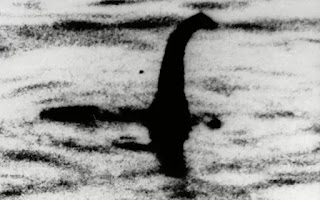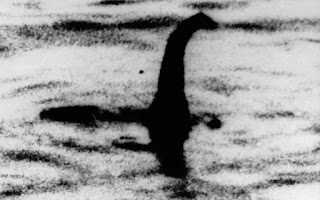The Loch Ness Monster
The Loch Ness Monster is a cryptid, a creature whose existence has been suggested but has not been discovered or documented by the scientific community. It is reputedly large unknown animal that inhabits Loch Ness in the Scottish Highlands,
It is similar to other supposed lake
monsters in Scotland and elsewhere, though its description
varies from one account to the next. Popular interest and belief in the
animal's existence has varied since it was first brought to the world's
attention in 1933. The most common speculation among believers is that the
creature
represents a line of long-surviving plesiosaurs. The scientific community regards the Loch Ness
Monster as a modern-day myth, and explains sightings as including
misidentifications of more mundane objects, outright hoaxes, and wishful
thinking
The term "monster" was reportedly applied for the
first time to the creature on 2 May 1933 by Alex Campbell, the water bailiff
for Loch Ness and a part-time journalist, in a report in the Inverness Courier.
On 4 August 1933, the Courier published as a full news item the assertion of a
London man, George Spicer, that a few weeks earlier
while motoring around the Loch, he and his wife had seen
"the nearest approach to a dragon or pre-historic animal that I have ever
seen in my life" trundling across the road toward the Loch carrying
"an animal" in its mouth.
The earliest report of a monster
associated with the vicinity of Loch
Ness appears in the Life of St.
the 7th century. According
Adomnán, writing about a century
after the events he described, the
Irish monk Saint Columba was
staying in the land of the Picts with
his companions when he came
across the locals burying a man by
the River Ness. They explained that the man had been
swimming the river when he was attacked by a "water beast" that had
mauled him and dragged him under. They tried to rescue him in a boat, but were
able only to drag up his corpse. Hearing this, Columba stunned the Picts by
sending his follower Luigne moccu Min to swim across the river.
The beast came after him, but
Columba made the sign of the Cross
and commanded: "Go no further. Do not touch the man. Go
back at once." The beast immediately halted as if it had been "pulled
back with ropes" and fled in terrot and both Columba's men and the pagan
Picts praised God for the miracle.
On 12 November 1933, Hugh
Gray was walking along the loch
after church when he spotted a
substantial commotion in the water. A large creature rose up
from the lake. Gray took several pictures of it, but only one of them showed up
after they were developed. This image appeared to show a creature with a long
tail and thick body at the surface of the loch. The image is blurred suggesting
the animal was
splashing. Four stumpy-looking
objects on the bottom of the
creature's body might possibly be a pair of appendages, such
as flippers.
A variety of explanations have
been postulated over the years to
account for sightings of the Loch
Ness Monster. These may be catego. rised as:
misidentifications of common animals; misidentifications of inanimate objects
or effects; reinterpretations of traditional Scottish folklore; hoaxes; and
exotic species of large animals.



No comments:
Post a Comment